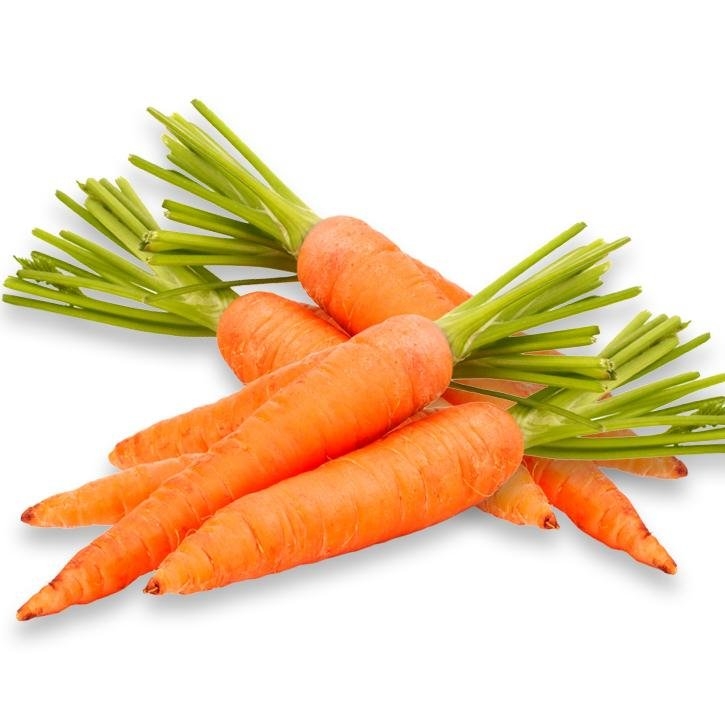Description
Pubescent plant, erect, biennial, 0.5-1 m high; spindle-like and reddish root. Leaves are pinnated and tomentose. The second year an angular and branched stem is produced with alternate leaves that end up in compact umbels of white flowers. Depending on its location at the flowered stems, the umbels may be terminal or primary, secondary, tertiary or even up to fourths, gradually reducing its size. Each umbel has plenty of white, small epigynous flowers, most of them hermaphrodites, with 5 small sepals and 5 either white or purple petals, 5 protandric stamens and a bicarpellate ovary provided with some nectaries. The fruit grows after the entomophilous crossed-pollination; it is a schizocarp formed by two prickly mericarps (achenia) that, when mature, are ventrally divided. Each of them holds one seed inside.
Practically, the root is considered the consuming part of the carrot; however, it is important to make clear that the product includes a part of the hypocotyl. This part widens and develops similar to the primary root, and form, this way an organic unit. The primary root rapidly elongates post-germination, reaching the typical cultivating length (variable between 3-30 cm) in less than a month. After that, comes the widening stage, which results from the cortex cambial zone; from secondary phloem outwards and secondary xylem inwards. In both tissues, parechymatous cells proliferate, and there is where the sucrose and other sugars are stored waiting for the next season to re-start their development and growth. At the same time, these cells contain pigments such as chlorophyll, carotenoids (alpha and beta), anthocyanine and lycopene, whose presence and relative concentration determine the color of the roots. The color goes from white to purple, prevailing orange in most of the cultivations.
Carrot is original from the Mediterranean eastern zone and Asia southeastern zone. Afghanistan would be the exact center of its origin due to the many different wild varieties found in there. The other zones mentioned would be merely secondary diversity centers. Even though, the species had been used by ancient Romans and Greeks with medicinal purposes, the first evidence of its cultivation was in Asia Minor. Only between the centuries XIV and XVII it became popular in Europe and Asia, being Netherlands the first country registered to cultivate orange carrots.
Part used
Mainly the root. Sometimes the fruits, too. (seeds).
Indications
Roots
- Promotes sun tanning, protects skin from the sun rays and improves the general conditions of skin.
- Skin disorders: dermatosis, ichthyosis, psoriasis, etc.
- Prevents premature skin aging. Excessive dry and rough skin.
- Dry and damage hair.
- Visual acuteness reduction. Night blindness. Corneal dryness.
- Excellent dietary supplement for children, elderly people, sportspeople and recovering patients.
- Children growth and bones and teeth weakness.
- Digestive disorders: gastritis and gastroduodenal ulcer, gastrointestinal infections.
- Diabetic patients.
- Malnutrition and anorexia.
- Diarrhea.
- To reinforce and improve body immune system.
- Respiratory system infectious diseases: sinusitis, tonsillitis, etc.
- Male infertility.
- Pregnancy, menstrual disorders.
- Antioxidant action due to its Vitamin A content. Antioxidants protect healthy cells in the body from free radicals damage preventing future diseases.
- Eczema, burns, skin ulcers, furuncles, chilblains, etc.
- It also has cosmetic uses: The juice or fresh pulp is used to make a face mask, as carrot has a relaxing and invigorating effect on the skin.
Bibliography
British Herbal Pharmacopoeia, 1990.
Plantas Medicinales. Thérapeutique-Toxicité. Christiane Vigneau. Masson, Paris 1985.
Matière Médicale (tomo II). RR Paris- H. Moyse. Masson 1981.
Fitoterapia: Vademecum de Prescripción. Plantas Medicinales. Colaboran: Asociación española de médicos naturistas. Colegio Oficial de Farmacéuticos de Vizcaya.
Plantas Medicinales. El Dioscórides Renovado. Pio Font Quer.
Guía de Campo de las Flores de Europa. Oleg Polunin. Ediciones Omega S.A. Barcelona, 1977.
Virtudes curativas de la zanahoria. Jorge Sites Pros.
The Natural Pharmacy. Miriam Polunin and Christopher Robbins.
Guía de las Plantas Medicinales. Cuarta edición. 1980. Paul Schanenberg / Ferdinand Paris.
Plantas y Flores Medicinales 2. Primera edición. 1982. Aldo Poletti.
Enciclopedia de las Plantas Medicinales. Biblioteca Educación y Salud. Jorge D. Pamplona Roger.
El libro de las Plantas Medicinales. M. Pahlow.
Plantes Médicinales des Régions Tempérées. L. Bézanger – Beauquesne & M. Pinkas. M. Torck & F.Trotin.
Bishayee A, Sarkar A, Chatterjee M. Hepatoprotective activity of carrot (Daucus carota L.) against carbon tetraclorhidre intoxication in mouse liver. J Ethnopharmacol 1995 Jul 7; 47 (2) :69-74.
Gambhir SS, Sen SP, Sanyal AK, Das PK. Antispasmodic activity of the tertiary base of Daucus carota L. sEeds. Indian J Phhysiol Pharmacol 1979 Jul-Sep;23 (3):225-8.
Gilani AH, Shaheen E, Saeed SA, Bibi S, Irfanullah. Hypotensive action of coumarin glycosides from Daucus carota. Phytomedicine. 2000 Oct;7(5):423-6. PMID: 11081994 [PubMed-indexed for MEDLINE].
